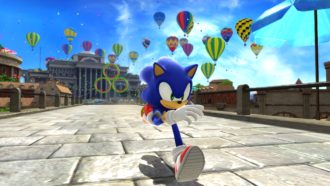Platforms:
Xbox One, PS4, PC, PS5, Xbox Series X|S
Released:
October 25, 2024
Publisher:
Sega
Developer:
Sonic Team
Sonic X Shadow Generations seems targeted specifically to fans like me, and not just because “Sonic X Shadow” is a term I’ve been intimately familiar with since the age of 13. If Sonic Generations is a celebration of the long history of the blue blur, then the added “Shadow Generations” content celebrates the slightly-less-long history of his rival, and Sonic Team has smashed it out of the park. Shadow’s stages improve on Generations’ level design and extra challenges to make this loving tribute to the Ultimate Lifeform one of the best Sonic titles in the last decade.
Shadow the Hedgehog is the coolest character ever created. That statement might immediately mark me as an embarrassing Sonic Adventure 2 tragic, but that’s just like, my truth, man. He’s a dark reflection of the main hero, Sonic; he’s got an edgy black and red colour scheme; he’s got a tragic backstory. He’s even got an aloof attitude that disguises a genuine compassion for the people he cares about. In short, he’s the best to ever do it. You may not agree with me, but it’s clear that Sonic X Shadow Generations does.
The added campaign, Shadow Generations, plays like a love letter to everything Shadow. His story begins with a retrospective of his origins so those not in the know can be brought up to speed. Just like in Sonic Generations, an entity called the “Time Eater” has messed up the timeline and has brought multiple levels from across the series together and trapped Shadow and his allies in a “White Space” hub world. Black Doom, Shadow’s nemesis from Shadow the Hedgehog, has taken advantage of the chaos and begins a last-ditch effort to gain enough power to turn the tables on Shadow. Shadow’s story is happening simultaneously with Sonic’s, and the two even interlink in one key moment where Sonic and Shadow repeat their final duel from Sonic Adventure 2. More than just a slapped-on morsel of content to sell the remaster, Shadow Generations is about as long as Sonic Generations in its own right, and even does it better due to the improvements it makes to the Generations-style level design and hub world.

It goes without saying that Shadow’s stages are all reimagined versions of his stages from games of the past, each coming with two Acts. While they’ve been redesigned, the stages still have more than enough design elements in common with the original, which makes them look and feel the same. If you played and enjoyed the original Sonic Generations, you’ll love these stages. Environments are a feast for the eyes and full of details, but the multiple possible routes are clearly visible using brightly lit rails and platforms. They aren’t hard to clear, but they may be hard to get that S rank on. They keep the speed and dynamic level design while eliminating some of the slower aspects that we weren’t such a fan of, like waiting for slow-moving platforms and standing on switches. There is still some slower platforming, primarily in Act 2 stages which are played in 2D, but they don’t feel as sluggish thanks to Shadow’s new Black Doom abilities. These abilities keep things moving fast and fluid, and feel well integrated into the level design so you feel rewarded for using them. The extra missions, marked by gates in the White Space hub world, help you practice each new ability Shadow unlocks, which is a much better reason for existing than their Sonic Generations counterparts (many of which I find to be time-wasters designed to pad out the game’s runtime) and therefore don’t feel like so much of a chore when you’re forced to complete them before being able to progress.
“Shadow Generations plays like a love letter to everything Shadow.”
Unlike Sonic Generations, where the story is completely separate from dialogue and cutscenes, in Shadow’s story many of the stages integrate a bit of the story into it, such as Black Doom’s eye appearing to antagonise Shadow or simply some internal commentary by Shadow. But it goes beyond just that. Sonic Team has placed a tonne of references to Shadow’s history in the cutscenes, sound design, abilities, and the extra collectables found in White Space. Bosses, such as the Biolizard, Metal Overlord, and Mephiles, have been completely reworked to be more like set-piece bosses, where opportunities to do damage are more clearly telegraphed, and more time is dedicated to dramatic moments of action and close-ups. In short, Shadow Generations takes every opportunity to make him look as cool as possible.

The White Space hub, which in Sonic Generations is a system of simple 2D platforms with not much substance, in Shadow Generations is a sprawling 3D world inspired by Sonic Frontiers. Like Frontiers, the only thing to do is grind on rails, collect rings, and pick up the odd collectable, but that actually makes more sense in the context of a hub world than it does as a full game. With a smaller map to work with, it feels packed with stuff and is more fun to explore and traverse. The collectables consist of iconic songs from Shadow’s levels, lost pages of Professor Gerald’s journal, and some honestly pretty cool concept art. There are still some awkward moments of finicky platforming that feel counter-intuitive for Shadow’s high-speed movement, but it’s not too bad. If Sonic Team is interested in developing the Frontiers-style map further in future games, this is definitely a step in the right direction.
Shadow Generations’ soundtrack matches the excellence of Sonic Generations, with remixed tracks that turn already-iconic songs into certified bangers. Sonic Team’s sound department never misses, but at this point, that’s no surprise.
Oh yeah, Sonic’s here too!
The remastered Sonic Generations almost seems like bonus content after the excellence that is Shadow’s story. As with any remaster, it’s gotten some marginal visual updates and gameplay tweaks, with the majority of the game playing and feeling the same as the original. That’s no bad thing, as Generations was and still is a great game. Its gameplay still largely holds up, though when played side by side with the Shadow content, you can easily see how the new content has improved on the old. Classic Sonic can now drop dash, which allows him to quickly drop to the ground and instantly charge a spin dash, but not much else about the gameplay has changed. That’s perfectly fine, since the marketing has been pretty clear that the main selling point is the Shadow side of Sonic X Shadow Generations. Cutscenes have been changed to make it more congruent with Shadow’s story, and a new minigame, Casino Nights, can be played from the White Space hub, where you can rank up points in pinball. These are nice additions, but the star attraction has got to be the 3 hidden chao that can be found in each Act.

Sonic Adventures 1 and 2 established a feature where Chao could evolve into a variety of shapes and colours based on whatever athletic stat you trained it in. The possible combinations of Chao are in the high double-digits, but this feature is not often acknowledged by the Sonic franchise, which usually only depicts Chao as one of the three standard evolutionary types: neutral, hero, or dark. That’s why it’s such a rare treat to see that the adorable Chao you can find hidden in each Act is one of the many different evolution varieties seen in SA2. Once found, they mill around their stage in the White Space, often playing with some object from the Chao Garden and generally being super adorable. It does sound like much when I write it down, but I can’t tell you the beams of sunshine I felt in my heart I felt every time I found a new one. I raised many of these Chao varieties across my multiple SA2 save files over the years, so it’s a reminder of a lot of my precious memories.
It wouldn’t be a Sonic Team game without a bit of jank. I was initially concerned when, on one of the first loop-de-loops on Green Hill Zone, Sonic’s model momentarily glitched out and spun around a few times as if undecided on which direction he should be going. This same glitch occurred when I played the demo at PAX Aus 2024, but thankfully nothing similar happened the rest of my playthrough. Boosting at the wrong moment can occasionally blast you into outer space, and the glide ability you unlock later in Shadow’s story can be a recipe for disaster if you’re not careful. Once or twice, I managed to get myself out of bounds. Thankfully, such incidents were infrequent enough that it didn’t get too aggravating. I noticed a few frame rate drops, which seemed to occur more in Sonic’s story than in Shadow’s. Both stories otherwise run in a smooth 60 FPS on PS5, though you need to turn on “Performance Mode” in Shadow’s story to get that.
In short, I haven’t had this much fun with a Sonic game in a long, long time. I know better than to ask for a Sonic Adventure 3; despite begging for it for more than a decade, SEGA and Sonic Team have never seemed keen to give the fans what they want. But if and when they ever decide to finally drag out the series for another try, I hope it looks like Shadow Generations. (But they should add a Chao Garden).
9
Amazing
Positive:
- Sonic Generations still holds up 13 years later
- Shadow Generations perfects the Generations-style level design
- Shadow's White Space hub world takes Frontiers' exploration and makes it better
- All the lore, references, and fan moments a Shadow fan could ever need
Negative:
- Boosts and loops result in occasional jank and glitches
Sonic X Shadow Generations gives Shadow fans everything they could wish for and more in this celebration of the Ultimate Lifeform’s history. The level design established in Generations and Sonic Frontiers has been perfected in the generously sized Shadow Generations storyline, with reimagined stages and boss fights from Shadow’s past appearances alongside heaps of references and tributes you’re bound to love.

















